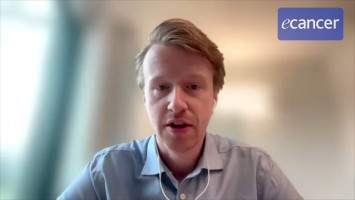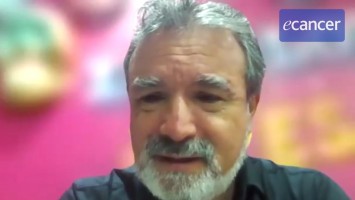ASCENT: A phase II trial of induction, consolidation and maintenance in subjects with high risk smouldering MM
Prof Andrzej Jakubowiak - University of Chicago, Chicago, USA
The study which I will be discussing evaluates a treatment strategy of high risk smouldering myeloma. Very briefly, myeloma once it has developed from MGUS is divided into smouldering and myeloma requiring treatment and smouldering myeloma is, by current guidelines, observed without therapy as at that stage of disease there is no evidence of organ damage. However, we recognise subsets of smouldering myeloma meeting criteria for high risk smouldering myeloma which is at increased risk of progression – by some criteria more than 50% of patients in three years will require treatment – and there is ongoing effort for the last several years to see whether intervention and treatment at this stage of disease would make a difference for patients. A general way of approaching has been by either trying to prevent progression to active myeloma by maybe more gentle interventions or by using more intensive interventions, as in this study which I will be discussing, where it’s an attempt to maybe potentially even eliminate the disease. That’s the background in which we have started the study.
What were the methods of the study?
We have taken advantage of previous work which was done in newly diagnosed myeloma. Among the most active regimens in myeloma is a combination of carfilzomib, lenalidomide and dexamethasone which has shown very high activity in a number of phase II studies. Newly diagnosed myeloma as well is at this meeting the FORTE trial which showed in a randomised large Italian study that, we call this regimen KRd in short, is highly active, generating high rates of stringent complete responses and MRD negative disease. So that was one of the reasons for the ASCENT trial, KRd as a backbone of treatment was selected with the goal to potentially achieve as high rates of non-detectable disease measured as stringent complete response as possible.
I would have to add that there is another similar study in progress in Spain, the study is called the CESAR trial, which is using KRd induction followed by transplant followed by KRd consolidation. Dr Marivi Mateos already presented the preliminary results of this study at a number of meetings, including at the last ASH 2019, showing truly high rates of complete and stringent complete responses and MRD negativity and very promising progression free survival curves which is eventually what will be measured in that particular study.
In the ASCENT trial which we discuss, we moved forward with the addition of an antibody, daratumumab, to KRd as a backbone rather than by using transplant like in the CESAR trial. But in general it’s a similar approach. It is using the best, as we think might be the best, tools we have in our anti-myeloma therapy toolbox for the treatment of high risk smouldering myeloma.
What were the key findings?
This is a very preliminary report at this meeting, indicating and focussed primarily on safety. The primary endpoint for this study is the rate of stringent complete response which we have not yet reported because the study is not mature enough to make this yet available for inclusion in our reporting. It’s per study design. So, to follow study design, the study has showed that there is very much expected tolerability, toxicity, based on the data which we generated in patients with newly diagnosed myeloma requiring treatment like, for example, in the FORTE trial which I mentioned or in recently published by Dr Jasielec [?] from the Multiple Myeloma Research Consortium, led by the University of Chicago study with KRd in transplant. Those studies have indicated there are some toxicities expected for both carfilzomib and lenalidomide in combination but we have not observed any increased risk of toxicities in the smouldering population.
Importantly, the rate of grade 3 or 4 toxicities or dose modifications was low. There was only one discontinuation out of a total of 54 patients so far enrolled for toxicity and overall the regimen has been fairly well tolerated, that’s our conclusion.
What’s next for the study?
I should mention that the study has a certain fixed treatment plan, it’s a one-arm study, there is no randomisation. There are six cycles of induction where the daratumumab antibody is given more intensively in a weekly schedule with KRd at optimal doses. Then six cycles of consolidation when daratumumab is given every four weeks. Then that’s followed by lenalidomide and daratumumab maintenance where daratumumab is given every week and lenalidomide at the maintenance schedule. So that’s the overall treatment plan.
We need to complete enrolment, for that particular study we are approaching the number of patients we need to be enrolled. We have observed patients on treatment long enough that we can potentially focus on our primary endpoint which is stringent complete response. Earlier results before this treatment is mature enough will not give us the information which we are looking for. The reason is that we have already observed and it has been clearly documented in a number of studies, including our KRd in transplant trial, that it takes time to reach a stringent complete response. In our study with transplant, for example, the median time to achieve a stringent complete response is about twelve months from the start of treatment and even beyond that point there are some patients who are increasing their stringent complete response. So to really know what is the rate of stringent complete response as primary endpoint we need a little bit more time, enrolling all patients and have all the patients advanced enough.
So that’s the next step, getting that study completed and generating enough results that we can look at our primary objective.
Is there anything else that you would like to add?
Yes, it is worth noticing that there is a lot of emerging data with quadruplet KRd and daratumumab combination which has been presented at prior meetings, including the results from the MASTER trial led by Dr Costa at the last ASH and also by Dr Landgren from Memorial Sloan Kettering Cancer Center with maybe a shorter duration, or eight cycles, of dara-KRd.
I want to add that I was presenting after I presented a very small, only over 20 patient, group of patients with newly diagnosed myeloma treated with a dara-KRd combination. Patients requiring treatment, so not smouldering myeloma, but the results after updates are really looking quite promising. The paper is under review pending the response of the reviewers so it will be probably published in the near future. It will probably be the first paper with this quadruplet combination giving viewers and those who are interested a sense of what is achievable with this quadruple combination. There are some differences in between different study designs with the quadruplet. We have ongoing KRd and dara treatment for 24 cycles which is also more or less halfway through enrolment so a lot of data with this quadruple is coming.
I would like to add that the ASCENT trial is collecting MRD data by next gen sequencing, also the MASTER trial as well as the Memorial Sloan Kettering Cancer Center who use MRD by flow but it’s still pretty sensitive, flow MRD. We are collecting MRD data in our study, a number of other studies as well. So we are still relatively early but preliminary results indicate that daratumumab, as expected, as it has been in some other quadruplet combinations, is improving depth of response, particularly rates of stringent complete responses and MRD negativity. They are beyond what we have already observed with KRd without daratumumab. For example, in our KRd and transplant trial, which is a little bit different because the transplant does have the potential of KRd but ultimately we had 70% of patients as best response achieving MRD negativity by current MWG criteria. So it just tells you that this is really a truly good backbone and I would anticipate that additional daratumumab instead of transplant may have similar potential in terms of efficacy as transplant and may potentially truly reduce the disease to depths which might be compatible with hope for a cure. That’s the ultimate objective of the smouldering study.
I would like to add that the reason why we are evaluating in smouldering myeloma is that, number one, we know that this group of patients will require a treatment as high probability in months or years to come. There is a presumption that in an earlier phase of myeloma, like in smouldering, even high risk, there may be less genetic dysregulations and maybe improved probability of achieving a better outcome than in myeloma which, by current criteria, requires treatment. So there is, in short, an attempt to really capture those two important background observations – that smouldering myeloma may need treatment and if we treat it earlier we may have a better chance of achieving even better responses than in newly diagnosed myeloma. Hopefully that’s the bottom line of where we are going, the elimination of the disease.
This ASH meeting deserves more than just a couple of sentences. There were a number of very intriguing and very well done studies looking at the biology of smouldering myeloma which seemed to be, in short, indicating that there is potentially an even more complex subset of myeloma patients in the smouldering phase, depending on their immune control which is changing over time and also some genetic composition of the myeloma, with some very bold proposals to identify smouldering myeloma as a composition of pre-smouldering myeloma, with a low probability of progression through active disease and with good control mostly by immune means, and the other group will be myeloma already marching to be active myeloma requiring treatment, just not yet at this stage by current criteria. What it means is that we may potentially refine our inclusion criteria in future studies and maybe focus on our efforts in maybe a first subset of myeloma with reasonable control on trying to find the ways that this control is preserved and maintained and keeps the disease from progression for the rest of the patient’s life. That would be very justified for this subset of patients and for the group which is essentially already myeloma but just not meeting CRAB and SLiM criteria, trying to find the most effective, curative approach with an attempt to elimination with the hope that this disease, indeed, could be more amenable to elimination than in later stages.








